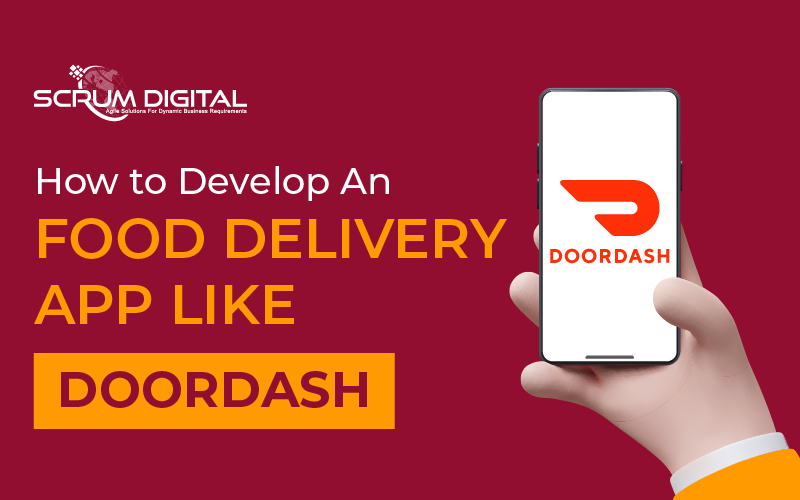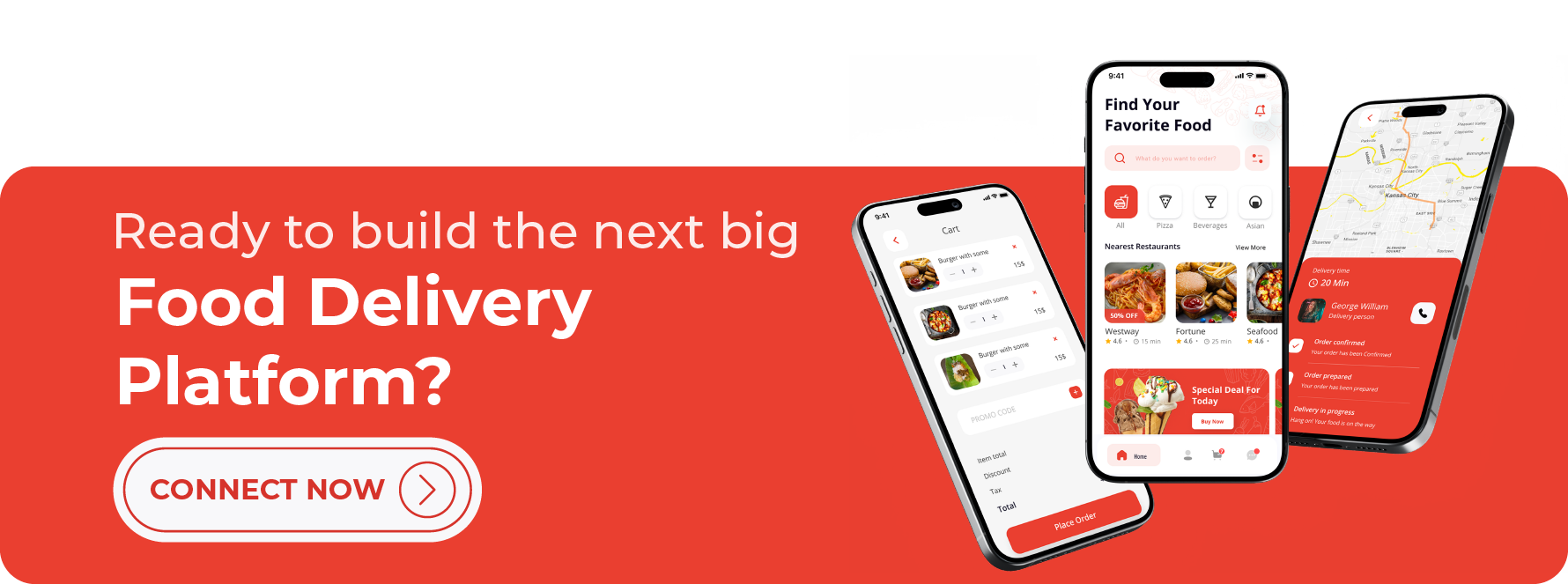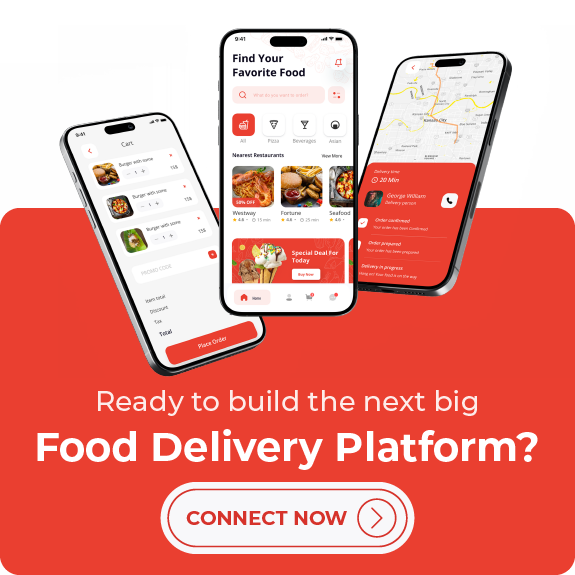In today’s era of convenience and efficiency, the food delivery industry has witnessed a remarkable surge in demand, presenting unparalleled opportunities for customer-centric businesses. Statista indicates the online food delivery market size in the United States, which alone reached an astonishing $185 billion in 2022.
It highlights the immense potential and profitability of this dynamic sector. With increasing numbers of consumers embracing the convenience of ordering meals at their fingertips, it is no surprise that food delivery platforms have become an integral part of our daily lives.
DoorDash is at the forefront of these platforms, captivating millions with its user-friendly interface, vast restaurant network, and innovative features.
If you’re exploring best app ideas, a food delivery app can be a lucrative option. By addressing customer pain points and integrating advanced features, businesses can carve a niche in this thriving market.
Curious about how much it costs to develop an app? In this step-by-step guide, we will navigate the intricacies of developing a feature-rich and user-friendly food delivery app like DoorDash that captivates your target audience and propels your business to new heights.
Why Should You Invest in a Food Delivery App Like DoorDash?
Investing in food delivery apps like DoorDash to make money offers a compelling opportunity to capitalize on the rapidly growing market for convenient food delivery services.
Here we will see the reasons why investing in a food delivery app similar to DoorDash can be a highly profitable venture.
1. Growing Market and Lucrative Earnings
The food delivery industry is experiencing exponential growth, presenting a prime opportunity for entrepreneurs and investors.
With the increasing reliance on mobile apps for ordering meals, apps like DoorDash have become integral to our lives.
By creating a one-demand food delivery app, you can tap into this expanding market, connect customers with local restaurants, and earn commissions on each order.
It’s a win-win situation for all parties involved: restaurants gain more customers, customers enjoy convenience, and you reap the financial benefits.
2. Following Success
DoorDash’s phenomenal success demonstrates the immense potential of food delivery services. By developing an app similar to DoorDash, you can leverage their proven business model and capitalize on their brand recognition.
Apps like DoorDash provide a familiar interface, enabling users to order from a wide selection of restaurants seamlessly.
By offering a comparable experience, you can attract users who are already accustomed to this style of food delivery, giving your app a head start in the market.
3. Multiple Revenue Streams
Investing in a food delivery app offers various revenue streams that contribute to its profitability. In addition to earning commissions from partner restaurants, you can implement additional monetization strategies.
These may include delivery fees, advertising partnerships with local businesses, and premium subscription services.
Diversifying your revenue streams allows you to maximize the app’s earning potential and create a sustainable business model.
Types of Food Delivery Application Models

There are several types of food delivery application models that cater to different customer preferences and business strategies. Let’s have a look at them:
1. Aggregator Model
The aggregator model is perhaps the most common type of food delivery application. In this model, the app serves as a platform that connects customers with a multitude of restaurants and facilitates the ordering and delivery process.
Companies like DoorDash and Uber Eats follow this model, allowing users to choose from a wide range of participating restaurants, place their orders, and have them delivered to their doorstep.
The aggregator model provides customers with a vast selection of dining options, while restaurants benefit from increased visibility and access to a broader customer base.
2. Restaurant-owned Model
In the restaurant-owned model, individual restaurants develop their own food delivery applications to offer their menu items directly to customers.
This model provides restaurants with greater control over the entire food delivery process, from order placement to delivery.
By eliminating the reliance on third-party platforms, restaurants can establish a direct connection with their customers, maintain brand consistency, and potentially reduce commission fees.
However, restaurants adopting this model need to invest in their own delivery fleet or partner with a delivery service for efficient order fulfillment.
3. Delivery Service Model
The delivery service model focuses primarily on the logistics aspect of food delivery. Companies that operate under this model, such as Postmates and Grubhub, partner with various restaurants and handle the delivery process on their behalf.
These apps act as intermediaries, coordinating between customers, restaurants, and delivery personnel. Customers can order from multiple restaurants through a single app, while restaurants can outsource the delivery aspect, thereby streamlining their operations.
The delivery service model is advantageous for restaurants that prefer to focus solely on their core business of preparing food.
4. Subscription-based Model
The subscription-based model is gaining popularity among food delivery applications. Companies like DoorDash and Postmates offer subscription plans that provide customers with benefits such as free delivery, exclusive discounts, and priority service.
Subscribers pay a recurring fee to access these perks, enhancing customer loyalty and encouraging frequent orders.
This model benefits both customers, who enjoy cost savings, and the app, which generates consistent revenue through subscription fees.
Step-By-Step Guide to Develop App Like DoorDash

Developing an app like DoorDash, a popular food delivery platform, is a complex endeavor.It involves a comprehensive process that encompasses various stages, each needing to be meticulously executed.
1. Define Your Vision
Identify your target market and understand their preferences and needs by conducting thorough market research and demographic analysis. This will help you tailor your app to meet the specific demands of your target audience.
Determine the unique selling points and value proposition of your app by conducting market surveys and focus groups to gather insights directly from potential users.
Research and analyze competitors to identify gaps and opportunities in the market, allowing you to position your app effectively and differentiate it from existing solutions.
2. Conduct Market Research
Identify current market trends and demand for food delivery apps by analyzing industry reports, market data, and consumer behavior patterns.
Study the behavior of potential users by conducting user interviews, observing their purchasing habits, and understanding their preferences for convenience, variety, and price.
Analyze the strategies and features of successful food delivery apps to gain valuable insights into their success and identify areas for improvement and innovation.
3. Outline the Features and Functionality
Create a comprehensive list of features that will enhance the user experience based on user feedback, market research, and industry best practices.
Prioritize essential features such as user registration, restaurant listings, menu browsing, order placement, payment integration, and delivery tracking to provide a seamless and convenient experience for users.
Consider additional features like customer reviews, loyalty programs, and personalized recommendations to add value and create a competitive advantage.
4. Design User-friendly Interfaces
Craft intuitive and visually appealing user interfaces by following user-centered design principles and conducting usability testing.
Ensure seamless navigation and easy access to key features by creating a clear and logical app flow. Use high-quality graphics, icons, and color schemes that align with your brand identity to create a visually appealing and cohesive user interface that engages users and encourages them to explore and use the app.
5. Develop the App
Choose the right technology stack and development framework based on the scalability, performance, and security requirements of your app.
Divide the development process into milestones to ensure efficient progress, frequent feedback, and the ability to adapt to changing requirements.
Implement robust backend systems that can handle user data securely, manage orders efficiently, and integrate with external services seamlessly to provide a smooth end-to-end experience.
6. Ensure Integration and Testing
Integrate with third-party services such as popular payment gateways, mapping APIs, and restaurant databases to enhance the functionality and user experience of your app.
Conduct comprehensive testing across multiple devices, platforms, and user scenarios to identify and fix any bugs, usability issues, or performance bottlenecks.
Perform load testing to ensure that your app can handle high user traffic and maintain optimal performance even during peak usage periods.
7. Secure App Launch
Prepare the necessary legal documentation, including terms of service, privacy policies, and user agreements, to protect your app and user data.
Obtain any required licenses or permits based on the regulatory requirements of your target market. Optimize the app store listing with compelling descriptions, screenshots, and relevant keywords to attract users and increase visibility in the app stores.
8. Deploy and Promote
Deploy your app on popular platforms like the Apple App Store and Google Play Store to reach a wider audience and maximize your app’s potential user base.
Implement effective marketing strategies such as social media campaigns, influencer partnerships, and targeted advertising to create awareness, generate interest, and drive app downloads.
Leverage user testimonials and positive reviews to build credibility and encourage user acquisition.
9. Gather User Feedback and Iterate
Encourage users to provide feedback and ratings through in-app surveys, feedback forms, and review prompts. Continuously monitor app performance and user behavior using analytics tools to gain insights into user preferences, usage patterns, and areas for improvement.
Regularly update your app with new features, bug fixes, and performance enhancements based on user feedback and market trends to ensure that your app remains relevant, engaging, and competitive.
10. Provide Ongoing Support and Maintenance
Establish a dedicated support team to promptly address user queries, resolve technical issues, and provide assistance throughout the user journey.
Monitor app performance, server uptime, and security to proactively identify and address any issues that may impact user experience.
Stay updated with emerging technologies, industry trends, and user expectations to ensure that your app evolves and continues to deliver value to your users.
Best Features to Include in Food Delivery App to Make it like DoorDash

To create a food delivery app that rivals the success of DoorDash, it’s essential to incorporate a range of features that enhance user experience, streamline operations, and provide convenience. Here are some key features to include in your food delivery app:
1. User-Friendly Interface
A clean and intuitive interface is crucial for attracting and retaining users. Ensure that your app offers seamless navigation, intuitive icons, and clear menus, making it easy for customers to browse through available restaurants and food options.
2. Extensive Restaurant Selection
Similar to DoorDash, offer a wide variety of restaurant options on your platform. Collaborate with local eateries, popular chains, and niche cuisines to provide users with an extensive selection of dining choices. Allow users to filter their searches based on preferences like cuisine type, dietary restrictions, and price range.
3. Real-Time Tracking
Implement a robust real-time tracking feature that enables users to track their orders from the moment they are placed until they reach their doorstep. This feature provides transparency and helps users plan their activities accordingly.
4. Delivery Partner Integration
Partner with a network of reliable and efficient delivery partners to ensure prompt and seamless order delivery. Implement a seamless integration system that connects delivery partners with the app, allowing them to manage their deliveries efficiently and update order statuses in real-time.
5. Personalized Recommendations
Leverage user data and preferences to provide personalized food recommendations. By analyzing previous orders, dietary preferences, and user ratings, the app can suggest tailored food options, leading to a more engaging and satisfying user experience.
6. In-App Payment
Facilitate secure and hassle-free payments within the app. Integrate popular payment gateways to enable users to pay for their orders using various methods, such as credit cards, mobile wallets, or digital payment platforms.
7. Reviews and Ratings
Enable users to share their feedback and rate their dining experiences directly within the app. By incorporating a review and rating system, users can make informed decisions based on others’ experiences, enhancing trust and transparency.
8. Order Customization
Allow users to customize their orders based on their preferences and dietary restrictions. Provide options for adding special instructions, modifying ingredients, or requesting specific cooking methods, ensuring that each order meets individual requirements.
9. Loyalty and Rewards Program
Implement a loyalty program that rewards users for their repeat orders. Offer incentives such as discounts, exclusive promotions, or free delivery to encourage customer loyalty and increase engagement.
10. Customer Support
Provide a reliable customer support system to address any queries or concerns promptly. Offer multiple channels for communication, including in-app chat support, email, or phone assistance, ensuring that users receive timely and efficient assistance whenever required.
Development Cost for Developing Food Delivery Apps like DoorDash

The development cost for a food delivery app like DoorDash can vary depending on several factors, including the complexity of the app, the features you want to include, the development platform, the team’s location, and the time required for development. Here are some key cost factors to consider:
-
Platform:
Decide whether you want to develop the app for a single platform (iOS or Android) or both (cross-platform). Developing for both platforms will require more time and resources, resulting in higher costs.
-
Design and User Interface:
The app’s design and user interface play a significant role in its success. Investing in an appealing and user-friendly design may involve hiring professional designers, which can increase the overall development cost.
-
Features and Functionality:
The complexity and number of features you want to incorporate into the app will impact the development cost. Features like real-time tracking, order customization, payment integration, and loyalty programs may require additional time and resources to implement.
-
Backend Development:
Developing a robust backend infrastructure is essential for managing orders, processing payments, integrating with restaurants and delivery partners and handling user data. The complexity of the backend system will affect the development cost.
-
Third-Party Integrations:
If you plan to integrate your app with external services such as payment gateways, mapping services, or analytics tools, additional costs may be incurred for licensing fees or API development and integrations.
-
Testing and Quality Assurance:
Thorough testing and quality assurance processes are vital to ensure a bug-free and reliable app. Allocate a budget for testing activities, including manual and automated testing, to deliver a stable and user-friendly app.
-
Maintenance and Updates:
After the initial development, you will need to consider the costs of ongoing maintenance, bug fixes, and updates. It’s important to keep the app up-to-date, address user feedback, and introduce new features to stay competitive in the market.
Considering all these factors, developing a food delivery app like DoorDash can range anywhere from $10k to $100k or even more. It’s crucial to conduct thorough planning, research, and budgeting, and work closely with a good App development team to get accurate cost estimates based on your specific requirements.
How Can Scrum Digital Help you Develop a Food Delivery App like DoorDash?

Scrum Digital understands the unique challenges and requirements of developing a food delivery app like DoorDash.
Our team of experts will work closely with you to define and prioritize features, ensuring that the app meets your specific business needs.
Here’s how Scrum Digital can help you develop a food delivery app like DoorDash:
- Expertise: Skilled professionals with knowledge of app development and the food delivery industry.
- End-to-End Solutions: From concept to deployment, seamless development process.
- User-Centric Design: Intuitive and engaging user interface for customer satisfaction.
- Agile Methodology: Transparent, collaborative, and adaptable development approach.
- Cutting-Edge Technologies: Latest trends, real-time tracking, secure payments, personalized recommendations.
- Customized Solutions: Tailored to your brand, goals, and target audience.
As a top mobile app development company in USA, Scrum Digital specializes in creating cutting-edge food delivery apps that meet the growing needs of the market. Our skilled professionals bring extensive expertise to deliver innovative solutions that align with your business goals.
Whether you’re looking to hire top mobile app developers, Scrum Digital offers a dedicated team ready to turn your vision into reality. Our developers ensure that your app features intuitive design, robust functionality, and seamless integration of the latest technologies.
Conclusion
As the demand for convenient food delivery services continues to rise, there will be ample opportunities for innovativeplatforms to emerge and capture the market.
With increasing consumer expectations, the future scope of food delivery apps remains promising, offering possibilities for expansion, improved user experiences, and enhanced features.
Embracing this trend and delivering exceptional services can lead to long-term success in the ever-evolving food delivery industry.
Contact us to create the best food delivery app for you.
FAQs
1. What are some popular apps like DoorDash?
DoorDash alternatives for food delivery services include Uber Eats, Grubhub, Postmates, and Instacart. These apps provide similar features and opportunities for delivery drivers and customers.
2. How can I develop an app like DoorDash?
To create an app like DoorDash, you need to follow a systematic approach. It involves conducting market research, defining requirements, designing the app, developing it with the help of a skilled team, and testing it thoroughly.
3. What is the cost of developing an app like DoorDash?
The development cost for a food delivery app like DoorDash depends on various factors like features, complexity, platform (iOS/Android), and development team rates. It can range from tens of thousands to hundreds of thousands of dollars.




